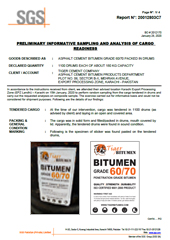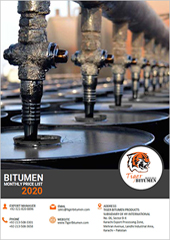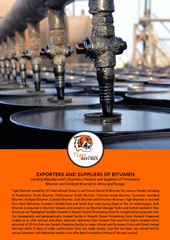Bitumen Mastic Exporter and Supplier
The assortment of Tiger Bitumen includes the whole range of Mastics based on construction bitumen. They are bitumen, bitumen-polymer, bitumen-emulsive and bitumen-latex mastics for roofing and waterproofing work. Depending on the kind of work produced, on the climatic conditions and on the volumes of work. Mastics of cold use (based on organic solvents or water) or Mastics of hot use (demanding initial heating) are applied.
Bitumen Mastics for Hot use
It is the most popular and time-proved method of use of bitumen waterproofing. As you chose Mastics of this kind the main criterion is usually the price for a square meter. Such Mastic (based on construction bitumen) should be warmed up before application to the temperature of 160-180С and being hot it is applied to the surface primed beforehand; and while it is getting cold the mastic creates a firm and elastic coating.
Bitumen Mastics for Cold use based on solvents
This method has already become usual during arrangement of bitumen waterproofing. Such Mastic is ready-to-use, it has different functions and is perfect for surface waterproofing of different kinds.
Bitumen Mastic Paving
It is spread with rakes as a loose mixture and afterwards compressed with heavy mechanically operated rollers, weighing from 5 to 1.0 tons. As Bituminous Mastic is used in buildings as a floor surface or over light foundation course as in a park or sidewalk or light driveway, it must necessarily be of such a nature that it can be put in place without a heavy roller, as is the practice in compressing bituminous street paving surfaces.
Bitumen Mastic Flooring
The presence in Bituminous Mastic of a surplus of bituminous binder has constituted a defect in such Mastic making it more or less plastic, and when heavy loads, or even moderate loads supported upon but a small area. Are placed upon it, they sink into and mark by indentations the floor or walk to an objectionable degree, making it unsightly and rough.
Bituminous Mastic has heretofore been made in two ways. The first and earliest way is to select and pulverize a native rock asphalt, usually and preferably a calcareous rock which is of a porous nature and has become impregnated through natural causes with a maltha or other form of native bitumen. Such rock carries from 5 to 10% bitupulverized and even when heated does not, bituminous mastic.
| Bitumen Mastic Specification | ||
| Property | VALUE | |
| Application Temperature | 50°F to 120°F (10°C to 49°C) | |
| Solids by Weight | 63% | |
| Thickness | ||
| Wet Film Thickness (WFT) | 30 mils (762 microns) min. | |
| Dry Film Thickness (DFT) | 20 mils (508 microns) min | |
| Theoretical Coverage | ||
| 20 mils (DFT) | 52 ft 2/gallon (4.8 m²/liter) | |
| 30 mils (DFT) | 39 ft 2/gallon (3.6 m²/liter) | |
| 40 mils (DFT) | 26 ft 2/gallon (2.4 m²/liter) | |
| Mix Ratio | Single Package | |
| Flash Point | 100°F (38°C) | |
| Drying Time | Touch Dry | Backfill Time |
| 20 mils | 2 hours | 24 hours |
| 30 mils | 2 hours | 24 hours |
| 40 mils | 2 hours | 24 hours |
| Resistance to Salts & Alkalies | Excellent | |
| Resistance to Water | Excellent | |
| Resistance to Oils, Greases & Solvents | Poor | |
| Service Temperature | 0°F to 150°F (-18°C to 65°C) | |





